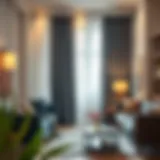Acacia Butcher Block Backsplash in Modern Kitchens
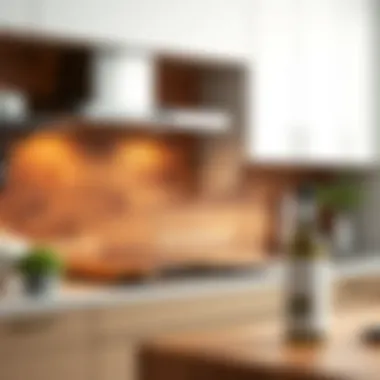

Intro
Lately, acacia butcher block backsplashes have been turning heads in kitchen decor. With their rich hues and warm textures, these wood accents can elevate the heart of a home. It’s not just about looks, though. Acacia wood combines beauty with strength, presenting a practical solution in a bustling kitchen environment. Have you ever considered how the right backsplash can tie your entire kitchen theme together?
Imagine a rustic farmhouse feel complemented by the earthy tones of acacia, or perhaps a sleek modern kitchen with rich accents that put a spotlight on craftsmanship. This article will explore how acacia butcher block backsplashes serve both aesthetic and functional purposes, guiding homeowners, designers, and decorators in their quest for the ideal kitchen environment.
Understanding the key benefits of acacia wood—its durability, maintenance ease, and sustainability—can empower you to make an informed choice that resonates with your personal style. From installation guidance to thoughtful design integration, we’ll serve up a comprehensive look at why more people are turning to acacia butcher block for their kitchen spaces.
Let’s delve deeper.
Design Inspiration
Trending Furniture Styles
When it comes to stylish kitchens, combining trends can create a timeless effect. Acacia butcher block backsplashes pair wonderfully with various furniture styles. Here are a few inspirations:
- Rustic Charm: Imagine a cozy space with reclaimed wood cabinets and wrought iron fixtures where an acacia backsplash could add a layer of warmth.
- Industrial Edges: Black metal accents and exposed brick contrast beautifully against rich, brown acacia tones, bringing a touch of elegance to raw materials.
- Modern Minimalism: In a sleek, white-dominated kitchen, a simple acacia backsplash can add just the right amount of contrast while keeping the aesthetic clean and sophisticated.
- Vintage Vibe: Pairing vintage-style cabinetry with an acacia accent can bridge old-world charm and contemporary design effortlessly.
Color Palettes and Combinations
The versatility of acacia wood extends beyond its texture; it harmonizes seamlessly with a variety of color palettes. Here are some combinations that can enhance its natural beauty:
- Whites and Neutrals: Bright whites make acacia's natural gloss really pop, creating an airy feel.
- Earthy Greens: Soft sage or fern greens can echo the outdoors, providing a refreshing backdrop to the rich color of acacia.
- Bold Contrasts: Deep navy or charcoal gray can lend a dramatic flair, allowing the lighter acacia tones to stand out.
- Pastels: Soft pinks or blues can provide a playful edge, particularly in family-friendly kitchens.
"The perfect color palette can turn a good kitchen into a great one, and acacia wood is the canvas upon which your culinary dreams can unfold."
Practical Advice
Furniture Maintenance Tips
Keeping your acacia butcher block looking fresh isn’t that tough. Here's what you need to do:
- Seal it Well: Ensure your backsplash is properly sealed to withstand moisture and stains.
- Regular Cleaning: Use a damp cloth to wipe it down daily. Avoid harsh chemicals that could damage the wood’s finish.
- Reapply Oil: Applying mineral oil every few months will keep the wood hydrated and looking its best.
Space Planning Solutions
Plan your kitchen layout with the backsplash as a focal point. Consider these options:
- Height Matters: Decide if you want a full-height backsplash or just behind key areas like the stove.
- Combine Materials: Think about blending the acacia with tiles, for an interesting texture combination.
- Functional Zones: Use the backsplash to designate areas like prep and cooking zones, enhancing both usability and aesthetics.
Navigating through the realms of acacia butcher block backsplashes can become a rewarding journey, as the balance between form and function leads to a beautifully designed space that feels uniquely yours. Check out resources like Wikipedia for more details on acacia wood, and consider visiting design forums on Reddit for ideas and tips from fellow enthusiasts.
Prelims to Acacia Butcher Block Backsplash
In the realm of kitchen design, the backsplash is often an afterthought, yet it can profoundly influence both functionality and aesthetics. An acacia butcher block backsplash offers a striking blend of beauty and utility, making it an increasingly favored choice among homeowners and designers alike. Its rich grain patterns and warm tones can transform an ordinary kitchen into a culinary showstopper. More than just a pretty face, this material is known for its durability, making it suitable for a space that often sees high traffic and moisture.
Integrating an acacia backsplash isn't merely a design choice; it’s a statement. With only a hint of rustic charm and a dash of modern elegance, this material fits seamlessly into many decor styles from contemporary to farmhouse. It's imperative to understand the properties of acacia wood and its rising popularity, as these two elements lay the foundation for appreciating its role in kitchen design.
Beyond aesthetics, an acacia butcher block backsplash invites practical considerations. Its maintenance, cost, and sustainability aspects deserve attention for homeowners who seek a long-lasting investment in their kitchen’s look and usability. Therefore, this section aims to provide a comprehensive overview of what makes acacia such a remarkable material for backsplashes.
Understanding the Material
Acacia wood, sourced from a variety of species, is recognized for its unique grains and colors. Typically, the wood exhibits a distinct mix of lighter and darker tones, offering a visually appealing contrast that is not easily replicated in other materials. One of the primary attributes that supports its use in busy kitchen environments is its reliability. Acacia is not only tough but also resists wear and tear remarkably well. This resilience translates to longevity in a kitchen backdrop, standing up to the humidity, heat, and even the occasional splash from cooking activities. Unlike some other woods, acacia doesn't easily warp or delaminate under moisture, a characteristic that makes it a favored choice for backsplashes.
Additionally, acacia has a reputation for being relatively easy to work with in terms of installation. The wood can be cut, shaped, and fitted without much hassle, an appealing quality for both DIY enthusiasts and professionals alike.
The Rise in Popularity
The popularity of acacia butcher block backsplashes has surged in recent years—an evolution that can be attributed to several factors. First, the shift towards more personalized and creative home design means that many homeowners are looking for unique statements that echo their individual style. Acacia wood, with its striking aesthetic and versatility, fits the bill perfectly. Instead of generic tile or stone, homeowners now desire something that exudes warmth and character.
Moreover, there’s a growing awareness surrounding sustainability. Acacia trees are often grown in managed forests, making them a more eco-friendly choice compared to other hardwoods. This environmental consciousness resonates with many, promoting acacia as a responsible choice for conscientious consumers.
As designers incorporate this material into a variety of kitchen styles, the demand has only continued to rise. People are no longer settling for the mundane; instead, they are opting for materials that add depth and charm to their spaces. Acacia wood is leading this charge, serving as a testament to the growing trend of merging beauty with practicality in today’s home design landscape.
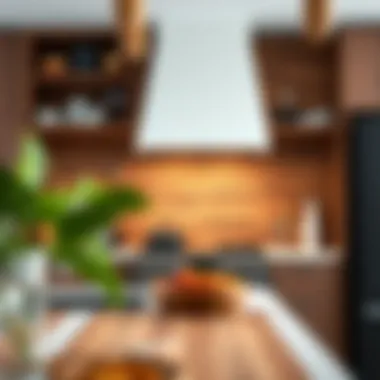

Characteristics of Acacia Wood
The unique features of acacia wood stand at the forefront of its appeal, especially when considering its use in butcher block backsplashes. Understanding these characteristics is essential for homeowners, designers, and decorators who are looking to enhance their kitchen spaces not just visually, but functionally as well. Acacia's diverse array of qualities allows for a multitude of applications, each yielding both aesthetic and practical benefits in contemporary home design.
Grain Patterns and Colors
One of the most striking aspects of acacia wood lies in its grain patterns and colors. Each piece of acacia features a mesmerizing tapestry of textures and hues, ranging from deep mahogany to lighter amber tones. This variance can add a sense of warmth and sophistication to any kitchen environment. The grain itself offers a rich, wavy appearance that is somewhat reminiscent of a flowing river, which can create a sense of depth when used as a backsplash.
- Visual Appeal: Thanks to its unique characteristics, no two pieces are ever identical, ensuring that every backsplash maintains a one-of-a-kind look.
- Design Versatility: The range of colors allows it to complement various kitchen themes—be it a minimalist approach or a rustic charm.
"When you choose acacia, you’re not just selecting a wood, you’re inviting nature’s artistry into your home."
Durability and Hardness
Durability is a critical factor when selecting materials for kitchen spaces. Acacia wood is known for its impressive hardness, which can withstand the wear and tear typical in high-traffic areas such as kitchens. In fact, it ranks quite favorably on the Janka hardness scale, making it more resilient than many other wood options. This durability translates to longevity, giving homeowners peace of mind that their investment in an acacia backsplash will stand the test of time.
Moreover, unlike softer woods that suffer dents and scratches easily, acacia's tough surface can endure bumps and impacts without showing significant wear. For homeowners who enjoy cooking regularly or entertaining guests, this characteristic is particularly valuable. The resilience of acacia means it can serve as both a functional work surface as well as a decorative element without compromising its integrity.
Resistance to Moisture
Kitchens are inherently humid environments due to cooking and cleaning activities, making moisture resistance a top priority for materials used in such spaces. Acacia wood possesses an innate ability to resist moisture, which helps in minimizing issues like warping, cracking, and developing mold over time. This quality is largely attributed to its dense cellular structure, which prevents water absorption.
- Less Maintenance: Homeowners can clean spills without worrying about their longevity.
- Long-term Value: The investment in acacia wood can save future costs tied to repairs or replacement usually incurred with lesser materials.
In summary, the characteristics of acacia wood—its striking grain patterns, exceptional durability, and resistance to moisture—make it an ideal choice for butcher block backsplashes. Together, these features not only enhance the visual appeal of a kitchen but also ensure it remains a practical and lasting choice for today’s modern homes.
Design Considerations
Design is the very essence of any space, especially in the kitchen, where functionality often twists and turns with aesthetics. When thinking of an acacia butcher block backsplash, considering the design not only enhances your kitchen’s visual appeal but also supports the overall functionality. This section explores how acacia can fit into diverse styles, marrying beauty with practical use.
Incorporating Acacia in Various Kitchen Styles
Modern Minimalist
Modern minimalist kitchens embrace simplicity and clean lines, making them popular choices for many homeowners. Utilizing an acacia butcher block in this setting lends an organic touch to an otherwise stark environment. The key characteristic of this style is its focus on the essentials, stripping away excess clutter while highlighting materials that speak to quality.
Incorporating acacia here acts like a breath of fresh air amidst concrete and steel, making the kitchen feel warm and inviting. However, the rich grain of acacia could stand out more than anticipated, thus requiring a careful balancing act. Too much contrast might disrupt the sleek look that minimalism celebrates.
Rustic Farmhouse
The rustic farmhouse style invokes warmth, charm, and a sense of nostalgia, seamlessly weaving together traditional elements with modern comforts. Adding an acacia butcher block creates an inviting centerpiece that captures the earthy essence of farmhouse decor. Its rich tones and unique grain patterns blend beautifully with distressed wood elements, creating a cohesive aesthetic.
A unique feature of the rustic farmhouse style is the use of vintage accessories and natural textures. However, this approach means it's essential to keep the butcher block well-maintained. Since it lives in a high-functioning environment, it requires a bit more care to keep it looking its best amid constant use.
Industrial Chic
Industrial chic channels a raw, edgy vibe that often leans on metals, exposed beams, and unrefined finishes. Here, an acacia butcher block stands out as an unexpected accent against the industrial backdrop of steel and concrete. The juxtaposition of the warm wood against cold metal is particularly striking and can serve as a focal point in an otherwise rugged environment.
The key characteristic of this style is its ability to mix textures effectively, creating a dynamic visual experience. An acacia backsplash in this context expresses creativity and unconventional thinking. However, too much wood can soften the bold character that industrial decor demands. Finding that sweet spot is crucial to enhance the overall design without losing the style’s signature appeal.
Color Pairing and Complementing Materials
Countertops
Choosing the right countertop is critical when integrating an acacia backsplash into your kitchen. Countertops made from materials like quartz, granite, or marble can offer a stunning contrast to the rich hues of acacia. A light-colored countertop could help accentuate the warmth of the wood, while darker tones create a dramatic effect.
The unique feature of opting for natural stone countertops is their durability. However, they often come with their own maintenance requirements, something to keep in mind when designing your kitchen.
Cabinets
The cabinets in your kitchen can significantly influence how an acacia backsplash looks in the overall design. Choosing lighter or white cabinets tends to make the wood stand out more, creating a vibrant contrast. Conversely, darker cabinets can create a more cohesive look, blending seamlessly with the acacia’s tones.
A benefit of lighter cabinets is their ability to make small kitchens feel bigger and brighter. But, too stark a choice could risk taking away from the beauty of the acacia. A careful balance here is key to achieving visual harmony.
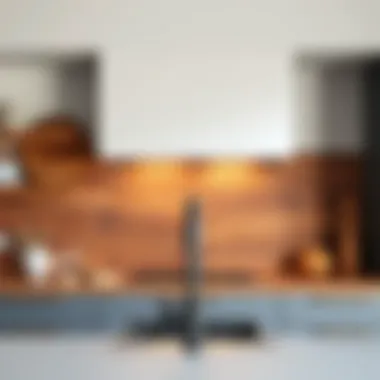

Flooring
The flooring presents another layer to consider. If you go for hardwood floors, ensure they are complementing or contrasting nicely with the butcher block. Tiles provide a durable option and can enhance the design if matched correctly.
A critical aspect of choosing flooring is the ease of cleaning and how well it meshes with both the backsplash and other elements in the kitchen. Natural wood flooring can introduce a sense of continuity, but it may require more upkeep than tiles, especially in busy kitchens.
Choosing the right complementing materials is not merely superficial; it builds a cohesive design narrative that captivates as much as it functions.
Installation Process
Installing an acacia butcher block backsplash is a crucial step for homeowners looking to enhance their kitchen's aesthetic and functionality. This section breaks down the installation process into understandable parts, ensuring that even those less experienced in DIY projects can approach it with confidence. Each stage is not just about laying wood; it’s about achieving a seamless integration with the existing kitchen elements, which can ultimately elevate the space's design and appeal.
Preparation of the Wall Surface
The foundation of a successful backsplash installation lies in proper preparation. Before any acacia panels make it to the wall, you must assess the surface where they will be applied. Identifying and correcting imperfections is paramount. An unprepped wall can lead to a host of issues, from misalignment to visible gaps.
- Clean Thoroughly: Begin by removing old backsplashes or any surface debris. Use a sponge and a solution of mild detergent to wipe down the area, ensuring it’s free of grease or dust.
- Smooth Surface: If your wall has textures or bumps, they should be sanded down. A smooth surface ensures better adhesion and minimizes the visual discrepancies once the panels are installed.
- Check for Level: It’s essential to confirm that the surface is level. Employ a level tool across the area. If you discover any dips, use a wall filler to even them out. This is a small effort now that pays off when the panels go up.
Preparing the wall is not just about removing the old; it’s setting the stage for the new.
Cutting and Fitting the Panels
Once the wall surface is ready, the next critical step is cutting and fitting the acacia panels precisely. This part requires careful measurement and a steady hand.
- Measure Twice, Cut Once: Mark the wall where the panels will sit using a pencil. Taking careful measurements is vital for a great fit.
- Cut to Size: Using a table saw or a circular saw, cut your acacia panels according to the measurements. If you're not comfortable cutting wood, it might be worth paying a professional or getting help from someone experienced to avoid mistakes.
- Dry Fit: Before fastening anything permanently, try placing the panels on the wall. This dry fit allows you to see how they align and ensures that any adjustments can be made easily beforehand.
Fitting the panels into place accurately is a key step that can determine the overall success of the installation. Even your great aesthetics can be marred by poorly-fitting pieces.
Securing the Backsplash
After ensuring that your panels fit snugly, it's time to secure them permanently. There are various methods of affixing your acacia panels to the wall, with each offering different levels of ease and durability.
- Adhesive Application: A construction adhesive works wonders with wood. Spread an ample amount on the back of each panel evenly, ensuring a good bond. Be mindful to avoid excess that may ooze out when pressed against the wall.
- Nail or Screw: For additional support, consider using finishing nails or screws. These can add extra durability to your installation. If you opt for screws, remember to pre-drill holes to avoid splitting the wood.
- Allow to Cure: Allow the adhesive to cure based on the manufacturer's instructions. Avoid putting pressure or contact on the panels until the adhesive has generally set.
Securing the backsplash is where your efforts truly come together. A well-installed backsplash not only serves as a protective element but also adds that desired touch of elegance that catches the eye.
Safety Tip: Always wear safety goggles and a mask while cutting wood to protect yourself from splinters and dust.
Installing an acacia butcher block backsplash is not without its challenges, but with the right approach, it can be a rewarding project that enhances your culinary space and leaves a lasting impact on your kitchen’s design.
Maintenance Tips
Maintaining an acacia butcher block backsplash is not just about keeping it looking good; it’s also essential for ensuring its longevity and functionality. With proper care, an acacia backsplash can resist wear and tear, thus retaining its allure and utility, transforming the kitchen into a space that’s both practical and visually appealing.
Cleaning Procedures
Cleanliness plays a vital role in maintaining the quality and appeal of your acacia butcher block backsplash. After all, this often-used surface will encounter splashes, spills, and various cooking residues. A consistent cleaning routine is key. Here’s how to go about it effectively:
- Daily Wipe Down: Use a soft cloth dampened with warm water to wipe the surface. For stubborn stains, a gentle soap solution can help. Avoid using harsh chemicals that might strip the wood of its natural oils.
- Avoid Soaking: Acacia wood doesn’t perform well with prolonged exposure to water. Make sure to dry the surface thoroughly after cleaning to prevent any moisture from seeping into the wood.
- Deep Cleaning: Once a month, consider a deeper clean using a mixture of baking soda and water to create a natural scrub that lifts tougher grime. Rinse well afterward.
By adhering to these cleaning steps, homeowners can maintain not only the wood's aesthetic but its overall quality too. Dirt may take center stage initially, but it should never steal the show. Protect that backsplash like it’s a fine art piece—a little attention goes a long way.
“The best maintenance is preventive care. Keeping surfaces clean and regularly inspected helps to prolong the life of your investment”.
Oil Treatments and Care
Proper oil treatment is a non-negotiable part of acacia maintenance. Natural oils keep the wood conditioned, prevent cracking, and maintain its vibrant colors. Here’s how to go about it:
- Frequency of Treatment: Aim to apply oil treatment every three to six months, depending on the kitchen's humidity and usage.
- Choosing the Right Oil: Food-safe mineral oil is often recommended, but some may choose to use an oil blend that includes beeswax for added moisture resistance.
- Applying the Oil: Using a soft cloth, apply the oil evenly across the surface. Allow it to soak in for about 20 minutes, then wipe off any excess. This prevents the wood from feeling greasy or looking shiny.
- Say No to Vegetable Oils: While it might be tempting to use kitchen oils, this is a firm no-no. Oils like olive can go rancid, creating unpleasant odors that can linger long after application.
In essence, treating your acacia butcher block backsplash with the right oils not only enhances its natural beauty but also fortifies it against day-to-day challenges often presented in a bustling kitchen. For those looking to maintain both functionality and style in their culinary space, these maintenance tips are invaluable.
For further insight, visit Wikipedia or Britannica for a deeper understanding of acacia wood and its properties.
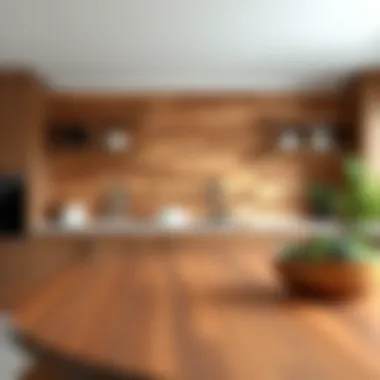

Cost Considerations
Understanding the cost associated with installing an acacia butcher block backsplash is crucial for homeowners and designers alike. It's not just about the initial outlay; it also incorporates long-term value and maintenance over time. Knowing the financial aspects can help in making informed decisions about this trendy yet functional design feature in your kitchen.
Budgeting for Acacia Backsplash
Budgeting effectively for an acacia backsplash involves more than simply setting aside a lump sum. Here are some factors to think through:
- Material Costs: Acacia wood can vary in price depending on factors like the grade of the wood, thickness, and finish. On average, standard acacia butcher block can range from $30 to $60 per square foot. However, specialty finishes could push the price higher.
- Labor Costs: If you're not a DIY enthusiast, hiring a professional for installation is wise. Labor can significantly inflate your budget. Depending on your location, labor rates can run anywhere from $50 to $100 per hour. It's often more economical to get a flat-rate quote for the whole project.
- Additional Materials: Don’t forget about adhesive, sealants, and tools if you plan on doing this yourself. They may seem small, but they can add up quickly, nudging your budget just a tad higher.
- Design Plans: If you're planning to integrate the backsplash with other elements, include those costs as well. New cabinetry or countertops can affect the overall expense.
Setting a budget based on these considerations will save you from surprises down the road. It helps to establish a range you're comfortable with, factoring in the total cost, including labor, materials, and any unforeseen expenses.
Cost vs. Value Comparison
When you invest in a new backsplash, it’s essential to weigh the cost against the value it brings to your kitchen. Here’s how acacia stands up:
- Aesthetic Appeal: Acacia’s unique grain patterns and warm tones can elevate the visual appeal of your kitchen. This can increase your home’s resale value, making it not just a lifestyle choice, but also a financial one in the end.
- Durability: Unlike some cheap alternatives, acacia is notably durable and resistant to scratches and splinters, which could save you money on future repairs or replacements. The lifespan of a quality backsplash could easily match or exceed the time you spend in your home.
- Maintenance Savings: While initial costs may be higher, the ease of maintenance of acacia wood could save you time and money. Regular oiling and proper care might be all that's required to keep it looking fresh.
Although the upfront cost might seem hefty, over time, the value of the quality and beauty of acacia can far outweigh that initial sticker shock. This makes it a wise investment for those looking to marry aesthetics with functionality in their kitchen.
Investing in an acacia butcher block backsplash can transform your kitchen into a space of beauty and durability, justifying its cost with aesthetic and functional gains.
In summary, while the budget for an acacia backsplash may initially give one pause, understanding its long-term value and maintenance needs can ease the mind. The investment can pay off with years of enjoyment and enhanced kitchen appeal.
Sustainability Aspects
In today’s world, where environmental concerns are increasingly taking center stage, it's essential to explore sustainable options for home improvement. The decision to use acacia butcher block backsplash not only revolves around aesthetics and durability but also reflects a conscious choice towards sustainability. This section will delve into the sources of acacia wood involved in creating this beautiful kitchen feature and the impacts associated with its harvesting.
Sources of Acacia Wood
Acacia wood is renowned for its rich colors and attractive grain, making it a popular choice among designers and homeowners. But beyond its beauty lies a deeper story regarding its sourcing. Acacia trees are predominantly found in tropical and warm temperate regions, such as Australia, Africa, and parts of Asia. The most common varieties used for butcher blocks include Acacia mangium and Acacia auriculiformis.
- Sustainable Forestry: Many acacia wood suppliers are committed to sustainable forestry practices. This involves careful management of forests to ensure that they can continue to produce resources for generations to come. An example is the Forest Stewardship Council (FSC) certification, which validates that wood is sourced from responsibly managed forests.
- Local Sourcing:
Sourcing acacia locally can significantly reduce the carbon footprint associated with transportation. Many manufacturers strive to purchase wood from nearby areas, minimizing environmental impact while supporting local economies.
Understanding where your acacia wood comes from is crucial for any eco-conscious consumer. Not only does it satisfy an aesthetic need, but it also aligns with ethical considerations that many modern homeowners are prioritizing.
Environmental Impact of Acacia Harvesting
Harvesting acacia wood can have significant environmental implications, which makes it crucial to recognize the practices that can mitigate potential harm. Here are some key elements to consider:
- Deforestation Risks:
If not managed properly, the demand for acacia wood can lead to overharvesting and deforestation. This can disrupt local ecosystems and threaten biodiversity. Sustainable practices aim to counteract these threats by ensuring that cutting is done at a rate that allows forests to regenerate. - Carbon Sequestration:
Acacia trees are known for their carbon sequestration capabilities, absorbing significant amounts of carbon dioxide from the atmosphere. When harvested sustainably, these trees can continue to contribute positively to the environment, unlike species that, once cut down, do not have a replenishing plan. - Soil Erosion:
Unsustainable farming and harvesting can lead to soil erosion. Acacia trees, when left standing in forests, help to anchor the soil, preventing loss due to rain and wind. Proper management during harvesting ensures the remaining trees can continue their vital roles.
In summary, while acacia wood is a beautiful option for kitchen backsplashes, understanding the sustainability aspects behind its sourcing and harvesting is paramount. Making informed choices not only enhances the aesthetic of your kitchen but also contributes to a more sustainable future.
"Prioritizing sustainability in home design is not merely a trend; it’s a necessary shift towards preserving our planet for future generations."
For further details on sustainable wood sourcing, you may explore resources from the Forest Stewardship Council at fsc.org or read about environmental impacts at wikipedia.org to expand your understanding.
Finale and Final Thoughts
As we wrap up our examination of acacia butcher block backsplashes, it’s clear this material offers a winning combination of beauty, functionality, and sustainability. Acknowledging the distinctive characteristics of acacia wood sets the stage for understanding its growing popularity in modern kitchens. It’s not just a passing trend; it reflects a deeper appreciation for materials that marry aesthetic charm with practical benefits.
Summarizing Benefits
Acacia butcher block backsplashes are treasured for several reasons:
- Aesthetic Versatility: With its warm tones and unique grain patterns, acacia can fit into a variety of kitchen styles, be it rustic, modern, or industrial.
- Durability: Known for its robustness, acacia wood resists wear and tear, making it suitable for the bustling kitchen environment where spills and splashes are part of the daily routine.
- Eco-Friendliness: Sourced sustainably, acacia wood contributes to environmentally conscious design without compromising quality or style.
"Opting for acacia means bringing not just wood, but a story of sustainability and craftsmanship into your home."
By understanding these advantages, homeowners can make an informed decision about incorporating acacia into their kitchen designs.
Future Trends in Kitchen Design
Looking ahead, the trend towards natural materials like acacia will likely continue its rise. Homeowners are increasingly prioritizing organic elements that contribute to a calming environment amidst the hectic pace of life. Here are some trends worth noting:
- Integration with Smart Technology: Expect to see more kitchens seamlessly blending natural materials with smart tech solutions. Acacia might be paired with touchless faucets or smart lighting that enhances its rich texture.
- Sustainability Focus: As awareness of environmental issues grows, homeowners will gravitate towards eco-friendly materials. Acacia's sustainable sourcing aligns perfectly with this trend.
- Custom Designs: With advances in woodworking technology, customization will become more accessible. Unique acacia backsplash designs can transform kitchens from standard to striking, tailored to individual tastes.
As the kitchen evolves into a multifunctional space, the choice of materials like acacia will play a crucial role in shaping the aesthetic and practical functionalities that cater to modern lifestyles.
